Starting With The Symptoms – What Your Plant Is Telling You
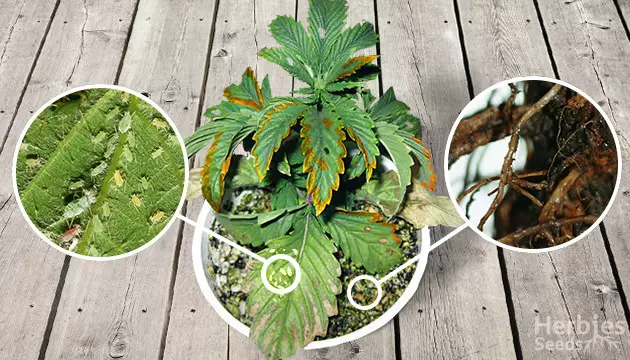
There are a multitude of health problems that can plague a marijuana plant. Nearly all of these issues share one thing in common: they present symptoms. When a grower ignores these symptoms, it can have negative repercussions on their marijuana plants. However, if you pay attention to what your cannabis plants are telling you, it’s possible to cure these problems! You can learn more about how to diagnose sick cannabis plants below.
Common Cannabis Health Problems
The world is a dangerous place for cannabis plants. Pests and diseases like mold, aphids, caterpillars, mildew and mites can all hurt plants and damage their quality and yields. In addition, there are several significant mistakes growers make that can decimate a garden. Some of these issues include overwatering, underwatering, light burn, and temperature and pH fluctuations.
Grower-Induced Issues
An inexperienced or careless grower can be more damaging to a garden than any pest or disease. Even with the best of intentions, a grower can ruin a crop if they don’t know what they’re doing. Don’t let this happen to you! Learning the symptoms of manmade cannabis plant problems can help a grower correct them when they occur. They can also prevent them entirely. Below are some of the most common health problems inadvertently caused by growers.
Symptoms Of Overheating

Unlike humans, plants – including cannabis – aren’t very good at regulating their own internal temperatures. As a result, they’re particularly vulnerable to extreme heat. When a plant is too hot, it will exhibit several symptoms. Initially, the edges of its leaves will begin to curl inward. This symptom is unique to heat stress, a difficult cannabis leaf problem for the untrained eye to notice at first. However, if you don’t correct the problem, the curling at the edge of the leaves will become extremely noticeable as the leaves turn yellow and brittle. While a plant is unlikely to die from high heat (unless it stays hot for many days in a row), high temperatures can cause photosynthesis to slow, proteins to break down and enzyme activity to falter. The result? Reduced flower weight and bud quality. To avoid overheating, always keep the temperature in your garden below 82 degrees Fahrenheit (28 degrees Celsius).
Light Burn – How To Spot It

Light is a crucial element that a plant needs for healthy growth. It powers photosynthesis, which allows the plant to grow larger and repair damage. However, too much of a good thing can turn toxic – that’s true even for marijuana plants. When a cannabis plant gets too much light, its leaves will begin turning yellow. This will usually start at the top of a plant because it’s closest to your light source. If you don’t fix the problem by moving the plant away from the light source, the leaves will start curling upward at the tips. They may also become “crispy” and brittle. If that happens, they’ll crumble and dissolve at your touch. Sometimes, an inexperienced grower can mistake light burn for another issue like overheating or nutrient deficiency. However, light burn can happen at any temperature, even if the plant isn’t overheating. Additionally, you can tell the difference between light burn and nutrient deficiency based on where your leaves are yellowing. If leaves are turning yellow toward the top of the plant (near the light source), you’re facing light burn. If leaves are yellowing down by the bottom of the plant, it’s probably nutrient deficiency.
Overwatering – Too Much Of A Good Thing
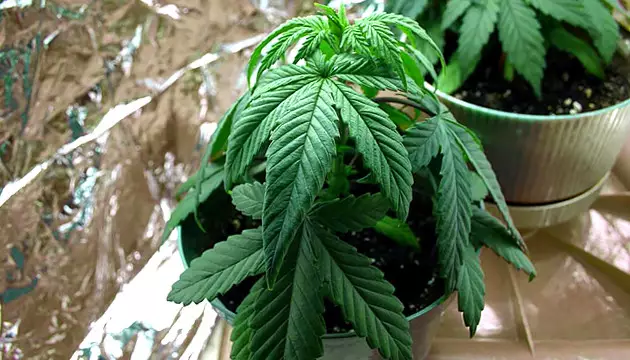
Water: it’s the source of a plant’s life. Water allows a plant to absorb nutrients and move them through its body. It can also help them regulate their temperature. However, following overwatering, plants can drown. If a plant’s roots are wet for too long, it can cause several problems. It might seem counter-intuitive, but if you water a plant too much, your leaves will get droopy and sad – just as though you were underwatering. When a plant is overwatered though, its leaves won’t change color. Instead, they’ll just be droopy. You can also pick up your plant’s container to feel how heavy it is. If the container is too heavy, it’s saturated with water. If it’s too light, your roots are dry.
Underwatering: It’s Easy To Prevent!

All plants need water to live, and weed is no different. If you fail to water your plants, they’ll tell you. First, the soil in your container will begin to look noticeably dry. Then, your plant’s leaves will begin to droop. If you don’t immediately water them, the rest of the plant will soon follow.
If you see a plant dry and drooping, you need to water it as quickly as possible to prevent long-term damage or death. However, cannabis plants can be extremely robust. Once you water your plants, you should notice them pop back to life within the space of just a few hours. The leaves will stop wilting and the plant will return to normal.
Don’t Overfeed! Plants Get Full, Too!

Overfeeding cannabis plants is a common mistake among new or inexperienced growers. While it’s important to make sure your plants have enough nutrients, simply stuffing a plant with food is a recipe for disaster. Also called “nutrient burn,” overfeeding is a problem that affects marijuana plant leaves in a unique way. Initially, you may notice that the tips of your leaves are turning brown, crispy and pointing upward. From there, nutrient burn moves to the interior of the leaf. Leaves may also curl downward. These problems will affect new growth while leaving old growth mainly unchanged. To solve nutrient burn, flush your soil with pH-neutral water. This will help your plant in two ways. First, it will wash out any extra nutrients in your soil. Second, it will dissolve any nutrients in your medium, allowing your plant to absorb it.
pH – Why It Matters

Think your plants may be nutrient deficient? There may be something else going on. Percent hydrogen, also known as pH, is a measurement of a solution’s acidity or alkalinity. It’s an extremely important measurement because it affects what nutrients a plant can absorb. Maintaining a pH between 5.5 and 7 is vital to the health of any weed garden. However, if pH fluctuates too much over a span of time, it can damage your plants. You’ll notice your leaves becoming mottled with yellow and brown spots while the outer edges begin to turn brown and dry out. If you see these problems, test the pH of your soil with a meter. If it’s below 5.5 or above 7, flush your plant out with pH-adjusted water to correct the problem.
Other Issues – Bugs, Fungi And Other Pests
Sometimes, a pest infestation is what’s wrong with your marijuana. Pests are the bane of gardens everywhere. Once an infestation breaks out in your garden, it can quickly develop into a crisis situation. Whenever pests are involved, an ounce of prevention is worth a pound of cure. In other words, the best way to beat infestations is to make sure they never happen. Keep your garden as clean as possible! However, if an infestation does break out in your garden, there’s always a way to kill a pest.
Mold

Are your plants beginning to grow yellow and droopy seemingly overnight? Mold is a common culprit. Usually, mold damage initially presents itself at the base of a leaf or bud (where it connects to the stem). Poor ventilation and high humidity are the two reasons behind mold infestations. Darkness also promotes fungal growth, so you may notice the symptoms of mold occur in your cannabis plants in the mornings. If your plants start molding, you need to remove any infected parts of the plant. However, you must do this carefully. Often, it’s a good idea to cover any infected branches with a plastic bag before you cut them off. This can help prevent the spread of mold to other parts of your plant.
Septoria

Septoria is a unique plant fungus that presents itself as yellow circles or blotches on your leaves. In fact, many different fungal diseases present themselves in circular patterns. Like other fungal infections, warm, wet conditions can often lead to Septoria outbreaks. If you leave a Septoria outbreak untreated, the spots will eventually turn brown. You can control Septoria outbreaks by carefully removing the infected area of your plant. Additionally, if any of your garden is tightly packed with plant matter, spread it out to ensure proper light penetration. You can also use a copper-based or broad-spectrum pesticide to treat the issue. To prevent Septoria from taking hold, use sulfur. Humans have used sulfur as a fungicide for thousands of years, so you know it works.
Mildew

Mildew is another fungal infection in cannabis plants. It’s a fairly unique leaf problem for marijuana, and you’ll know it as soon as you see it. The most common type of mildew is powdery mildew, which will appear as small, white, fluffy circles on your leaves (like drops of powdered sugar). Powdery mildew is the bane of many cannabis gardens. In fact, professional growers can lose their jobs if powdery mildew infests their commercial grows. Powdery mildew is a highly contagious pathogen. Once it infects a plant, it stays dormant until a combination of high heat, high humidity and low light triggers its reproduction. That’s when you’ll see the white spots begin to appear. As with Septoria, sulfur sprays can be an effective deterrent to mildew infestations.
Root Rot

Root rot is a fungal infection caused by roots that stay too wet and dark for too long. Because roots are underground, they never see any light. As a result, rot can quickly take hold. You’ll first notice symptoms of root rot in the part of your plant that’s above the ground. Your plants will be extremely droopy, but may stay green and healthy-colored. Symptoms can be similar to underwatering, except that the opposite is true: your roots are too wet. If you’re running a hydroponic system, check your plant’s roots. They’ll be slimy and brown rather than the healthy, fuzzy white that indicates healthy roots. Root rot also has a distinctive odor that will permeate a grow. Stay vigilant – root rot spreads through water and can quickly reach panic levels in a hydro grow.
Aphids

These soft-shelled bugs are often white, but can also be green, yellow, black, brown or even red-colored. It all depends on where in their lifecycle you catch them. Sometimes, they may even have wings. They’re one of the most common cannabis pests in the world and are unusually hardy to environmental changes. You’ll first notice aphids because small yellow pinpricks are appearing on your leaves. When you turn your leaves over, you’ll see that the underside is covered with small bugs helping themselves to a quick snack. If left unchecked, they can drain your entire plant of vital fluids. Once an aphid gets old enough, it will grow wings and fly to another plant. This development can happen in a matter of days, so aphid infestations can spread quickly. To get rid of them, try spraying with neem oil or pyrethrin.
Caterpillars

In spite of being much larger than many cannabis pests, caterpillars can be tough to catch in the act. At first, you may only notice holes in your leaves and small pellets of black or brown dust on them. However, don’t assume that this is some kind of problem with your marijuana plants’ leaves. Usually, leaves won’t just develop holes without showing some discoloration first. Instead, these holes are caused by vicious bugs that can quickly devastate your garden. There are countless different types of caterpillars that can infest cannabis grow. Luckily, safe and organic pesticides such as neem oil sprays can help you get the issue under control. After you treat your plants with a pesticide spray, make sure to keep a close eye on them so the infestation doesn’t come back!
Maggots
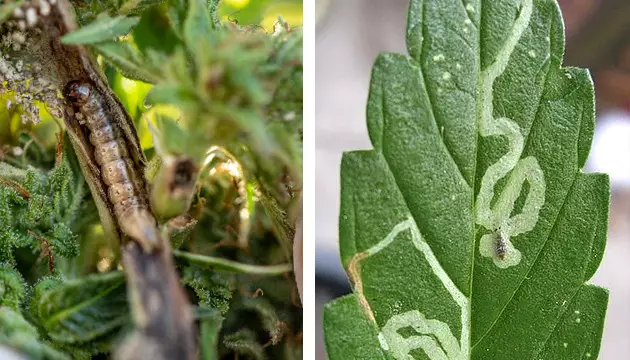
Unfortunately, finding maggots in your roots isn’t just gross – it’s also inconclusive. Maggots could turn into several different pests. One of the most common, however, is fungus gnats. These little bugs are naturally attracted to wet soil and low light. They mature in a plant’s root system before transforming into a fly and moving upward into its leaves and buds. You may find some small flies trapped in the sticky top buds of mature plants. It’ll look like someone sprinkled cracked pepper over them. These are the end result of a fungus gnat infestation. To get rid of maggots in your roots, drench your media with pesticides.
Slugs

Often, an inexperienced grower can mistake slug damage for caterpillar damage. Both slugs and caterpillars can take large bites out of your leaves, causing significant and possibly incurable damage if you don’t act against them. However, one major difference separates slugs from caterpillars: slime trails. If you see trails of slime across your leaves, the culprit is likely a slug. While you’ll probably notice damage to your leaves, slugs eat flowers too. As a result, they can quickly turn a healthy plant with plenty of quality buds into a husk. Usually, they’ll work overnight. If your plant is a young seedling, a slug can eat the entire plant overnight, pulling off an unwelcome vanishing act.
Spider Mites

These ruthless little predators can be the bane of many a garden. While many pests are insects, spider mites are actually tiny spiders that will eat your flowering buds. You’ll know spider mites when you see them. Usually, an infestation doesn’t become apparent until late in the flower cycle. Usually active at night, they’ll form webs over the tops of your colas. As a result, spider mite infestations can pop up seemingly overnight. If left unchecked, spider mites can run rampant in a garden. If you notice multiple harvests with spider mite infestations, check out the veg area in your garden. Chances are, there’s an early-stage infestation in your vegetative garden that you’re unwittingly transferring into your flower room with every harvest.
Nutrient Deficiency And Toxicity Chart
Nutrient deficiencies are one of the most common problems affecting a cannabis plant’s health. Check out our chart detailing deficiencies and toxicities below if you think your marijuana plants are facing a nutrient problem.
You’re Ready To Diagnose Your Plants
Now that you have a working knowledge of marijuana diseases and deficiencies, you’ll be able to take the appropriate actions to fix them. Troubleshooting marijuana plants can be a tough task, though. When making a diagnosis in your cannabis garden, make sure you’re not confusing one type of disease or deficiency with another. With careful practice, you’ll be able to keep your garden safe and healthy, growing huge yields time after time!
Herbies Head Shop expressly refuses to support the use, production, or supply of illegal substances. For more details read our Legal Disclaimer.





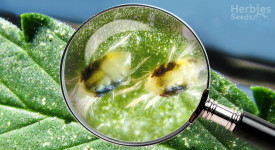












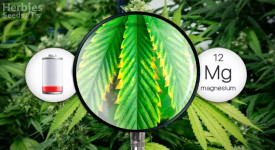
Thank you for leaving a comment for us!
Your feedback will be posted shortly after our moderator checks it.
Please note that we don’t publish reviews that: